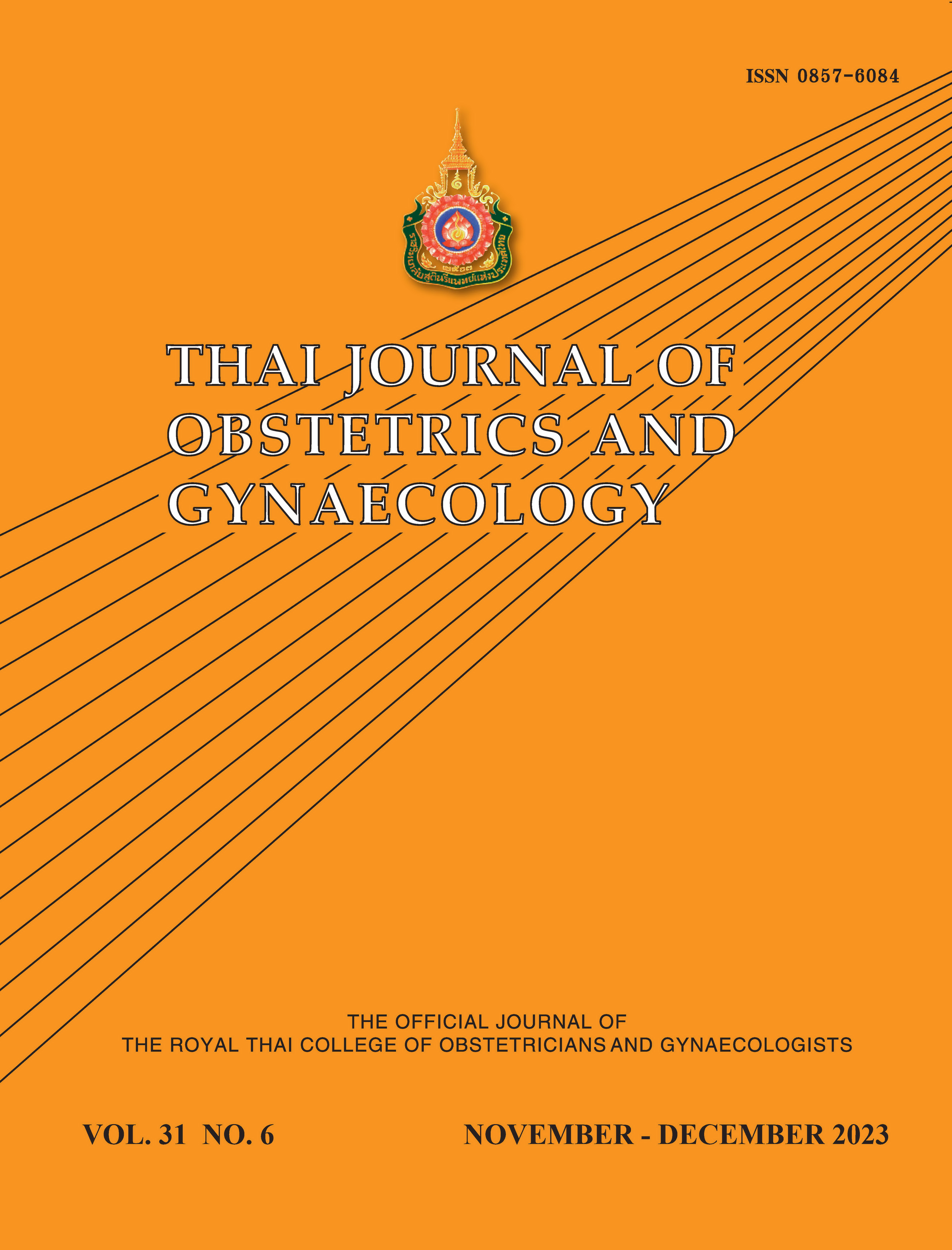Rate of Large for Gestational Age Newborn Between Gestational Diabetes Mellitus followed-up by One-hour Postprandial Plasma Glucose and Two-hour Postprandial Plasma Glucose
Main Article Content
Abstract
Objectives: To compare the rate of large for gestational age (LGA) newborns, adverse perinatal, and obstetrical outcomes in gestational diabetes mellitus (GDM) followed-up by one-hour postprandial glucose (1-HrPPG) and two-hour postprandial glucose (2-HrPPG), and to study the risk factors increasing the rate of LGA newborns.
Materials and Methods: In this retrospective cohort study, Thai singleton pregnancies with GDM diagnosed by using the Carpenter and Coustan criteria who were regularly followed-up and delivered a live birth after 28 weeks of gestation at Prapokklao Hospital between October 2017 to July 2022 were enrolled. The participants were classified into two groups based on the follow-up method. The data were collected from the medical records and analyzed by SPSS version 26.0.
Results: Four hundred and seventy-eight participants were included and divided into two groups of 239 participants each. There were no differences in the baseline characteristics. In the obstetrical outcomes, metformin was used more (16.3% vs 4.2%, p < 0.001) in the 1-HrPPG group, but the others were not different. For the neonatal outcomes, the mean birthweight was higher in the 1-HrPPG group (3180.8 ± 460.6 vs 3098.0 ± 434.9 grams, p = 0.044), but the rate of LGA was not different (20.5% vs 20.1%, p = 0.909). After the logistic regression analysis, the excessive gestational weight gain doubled the risk of LGA.
Conclusion: The rate of LGA newborns in GDM who were followed-up by 1-HrPPG or 2-HrPPG was not different, and the appropriate gestational weight gain could reduce the rate of LGA.
Article Details

This work is licensed under a Creative Commons Attribution-NonCommercial-NoDerivatives 4.0 International License.
References
ACOG Practice Bulletin No. 190: Gestational diabetes mellitus. Obstet Gynecol 2018;131:e49-e64.
Cho NH, Shaw J, Karuranga S, Huang Y, da Rocha Fernandes J, Ohlrogge A, et al. IDF Diabetes Atlas: Global estimates of diabetes prevalence for 2017 and projections for 2045. Diabetes Res Clin Pract 2018;138:271-81.
Egan AM, Dunne FP. Optimal management of gestational diabetes. Br Med Bull 2019;131:97-108.
Ferrara A. Increasing prevalence of gestational diabetes mellitus: a public health perspective. Diabetes Care 2007;30:S141-S6.
Weisz B, Shrim A, Homko CJ, Schiff E, Epstein GS, Sivan E. One hour versus two hours postprandial glucose measurement in gestational diabetes: a prospective study. J Perinatol 2005;25:241-4.
Ozgu-Erdinc AS, Iskender C, Uygur D, Oksuzoglu A, Seckin KD, Yeral MI, et al. One-hour versus two-hour postprandial blood glucose measurement in women with gestational diabetes mellitus: which is more predictive? Endocrine 2016;52:561-70.
Farrar D, Duley L, Dowswell T, Lawlor DA. Different strategies for diagnosing gestational diabetes to improve maternal and infant health. Cochrane Database Syst Rev 2017;8:Cd007122.
Martis R, Crowther CA, Shepherd E, Alsweiler J, Downie MR, Brown J. Treatments for women with gestational diabetes mellitus: an overview of Cochrane systematic reviews. Cochrane Database Syst Rev 2018;8:Cd012327.
Egan AM, Simmons D. Lessons learned from lifestyle prevention trials in gestational diabetes mellitus. Diabetic Med 2019;36:142-50.
Kallem VR, Pandita A, Pillai A. Infant of diabetic mother: what one needs to know? J Matern Fetal Neonatal Med 2020;33:482-92.
Heiskanen N, Raatikainen K, Heinonen S. Fetal macrosomia--a continuing obstetric challenge. Biol Neonate 2006;90:98-103.
Jolly MC, Sebire NJ, Harris JP, Regan L, Robinson S. Risk factors for macrosomia and its clinical consequences: a study of 350,311 pregnancies. Eur J Obstet Gynecol Reprod Biol 2003;111:9-14.
Carpenter MW, Coustan DR. Criteria for screening tests for gestational diabetes. Am J Obstet Gynecol 1982;144:768-73.
World Health Organization. The Asia-Pacific perspective: redefining obesity and its treatment. 2000.
Institute of Medicine, National Research Council Committee to Reexamine Institute of Medicine Pregnancy Weight Guidelines (IOMPWG). The National Academies Collection: Reports funded by National Institutes of Health. In: Rasmussen KM, Yaktine AL, editors. Weight gain during pregnancy: Reexamining the guidelines. Washington (DC): National Academies Press (US), National Academy of Sciences 2009.
Balest AL. Large-for-gestational age (LGA) newborn. In: Merck & Co, Inc.; 2021.
Villar J, Cheikh Ismail L, Victora CG, Ohuma EO, Bertino E, Altman DG, et al. International standards for newborn weight, length, and head circumference by gestational age and sex: the newborn cross-sectional study of the INTERGROWTH-21st project. Lancet 2014;384:857-68.
Davis DD, Roshan A, Canela CD, Varacallo M. Shoulder dystocia. In: StatPearls. Treasure Island (FL): StatPearls Publishing, StatPearls Publishing LLC.; 2022.
Pregnancy at age 35 years or older: ACOG Obstetric Care Consensus No. 11. Obstet Gynecol 2022;140:348-66.
Brand KMG, Saarelainen L, Sonajalg J, Boutmy E, Foch C, Vääräsmäki M, et al. Metformin in pregnancy and risk of adverse long-term outcomes: a register-based cohort study. BMJ Open Diabetes Res Care 2022;10:e002363.
Brand KM, Thoren R, Sõnajalg J, Boutmy E, Foch C, Schlachter J, et al. Metformin in pregnancy and risk of abnormal growth outcomes at birth: a register-based cohort study. BMJ Open Diabetes Res Care 2022;10:e003056.
Kim SY, Sharma AJ, Sappenfield W, Wilson HG, Salihu HM. Association of maternal body mass index, excessive weight gain, and gestational diabetes mellitus with large-for-gestational-age births. Obstet Gynecol 2014;123:737-44.
Boriboonhirunsarn D, Kasempipatchai V. Incidence of large for gestational age infants when gestational diabetes mellitus is diagnosed early and late in pregnancy. J Obstet Gynaecol Res 2016;42:273-8.
Bhavadharini B, Anjana RM, Deepa M, Jayashree G, Nrutya S, Shobana M, et al. Gestational weight gain and pregnancy outcomes in relation to body mass index in asian indian women. Indian J Endocrinol Metab 2017;21:588-93.


